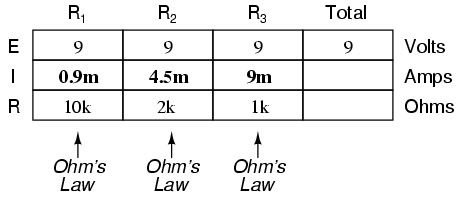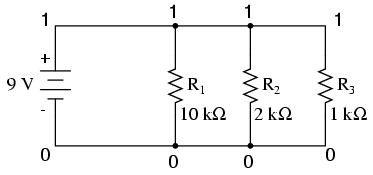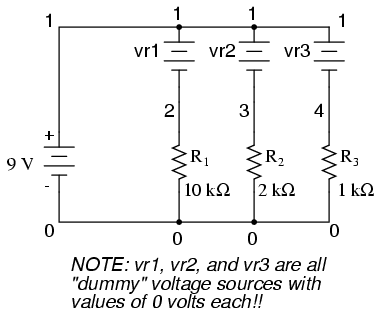Simple parallel
circuits
Let's start with a parallel circuit
consisting of three resistors and a single battery:

The first principle to understand about
parallel circuits is that the voltage is equal across all
components in the circuit. This is because there are only
two sets of electrically common points in a parallel
circuit, and voltage measured between sets of common points
must always be the same at any given time. Therefore, in the
above circuit, the voltage across R1 is equal to
the voltage across R2 which is equal to the
voltage across R3 which is equal to the voltage
across the battery. This equality of voltages can be
represented in another table for our starting values:

Just as in the case of series circuits, the
same caveat for Ohm's Law applies: values for voltage,
current, and resistance must be in the same context in order
for the calculations to work correctly. However, in the
above example circuit, we can immediately apply Ohm's Law to
each resistor to find its current because we know the
voltage across each resistor (9 volts) and the resistance of
each resistor:


At this point we still don't know what the
total current or total resistance for this parallel circuit
is, so we can't apply Ohm's Law to the rightmost ("Total")
column. However, if we think carefully about what is
happening it should become apparent that the total current
must equal the sum of all individual resistor ("branch")
currents:

As the total current exits the negative (-)
battery terminal at point 8 and travels through the circuit,
some of the flow splits off at point 7 to go up through R1,
some more splits off at point 6 to go up through R2,
and the remainder goes up through R3. Like a
river branching into several smaller streams, the combined
flow rates of all streams must equal the flow rate of the
whole river. The same thing is encountered where the
currents through R1, R2, and R3
join to flow back to the positive terminal of the battery
(+) toward point 1: the flow of electrons from point 2 to
point 1 must equal the sum of the (branch) currents through
R1, R2, and R3.
This is the second principle of parallel
circuits: the total circuit current is equal to the sum of
the individual branch currents. Using this principle, we can
fill in the IT spot on our table with the sum of
IR1, IR2, and IR3:

Finally, applying Ohm's Law to the rightmost
("Total") column, we can calculate the total circuit
resistance:

Please note something very important here.
The total circuit resistance is only 625 Ω: less than
any one of the individual resistors. In the series circuit,
where the total resistance was the sum of the individual
resistances, the total was bound to be greater than
any one of the resistors individually. Here in the parallel
circuit, however, the opposite is true: we say that the
individual resistances diminish rather than add
to make the total. This principle completes our triad of
"rules" for parallel circuits, just as series circuits were
found to have three rules for voltage, current, and
resistance. Mathematically, the relationship between total
resistance and individual resistances in a parallel circuit
looks like this:

The same basic form of equation works for
any number of resistors connected together in parallel,
just add as many 1/R terms on the denominator of the
fraction as needed to accommodate all parallel resistors in
the circuit.
Just as with the series circuit, we can use
computer analysis to double-check our calculations. First,
of course, we have to describe our example circuit to the
computer in terms it can understand. I'll start by
re-drawing the circuit:

Once again we find that the original
numbering scheme used to identify points in the circuit will
have to be altered for the benefit of SPICE. In SPICE, all
electrically common points must share identical node
numbers. This is how SPICE knows what's connected to what,
and how. In a simple parallel circuit, all points are
electrically common in one of two sets of points. For our
example circuit, the wire connecting the tops of all the
components will have one node number and the wire connecting
the bottoms of the components will have the other. Staying
true to the convention of including zero as a node number, I
choose the numbers 0 and 1:

An example like this makes the rationale of
node numbers in SPICE fairly clear to understand. By having
all components share common sets of numbers, the computer
"knows" they're all connected in parallel with each other.
In order to display branch currents in
SPICE, we need to insert zero-voltage sources in line (in
series) with each resistor, and then reference our current
measurements to those sources. For whatever reason, the
creators of the SPICE program made it so that current could
only be calculated through a voltage source. This is
a somewhat annoying demand of the SPICE simulation program.
With each of these "dummy" voltage sources added, some new
node numbers must be created to connect them to their
respective branch resistors:

The dummy voltage sources are all set at 0
volts so as to have no impact on the operation of the
circuit. The circuit description file, or netlist,
looks like this:
Parallel circuit
v1 1 0
r1 2 0 10k
r2 3 0 2k
r3 4 0 1k
vr1 1 2 dc 0
vr2 1 3 dc 0
vr3 1 4 dc 0
.dc v1 9 9 1
.print dc v(2,0) v(3,0) v(4,0)
.print dc i(vr1) i(vr2) i(vr3)
.end
Running the computer analysis, we get these
results (I've annotated the printout with descriptive
labels):
v1 v(2) v(3) v(4)
9.000E+00 9.000E+00 9.000E+00 9.000E+00
battery R1 voltage R2 voltage R3 voltage
voltage
v1 i(vr1) i(vr2) i(vr3)
9.000E+00 9.000E-04 4.500E-03 9.000E-03
battery R1 current R2 current R3 current
voltage
These values do indeed match those
calculated through Ohm's Law earlier: 0.9 mA for IR1,
4.5 mA for IR2, and 9 mA for IR3.
Being connected in parallel, of course, all resistors have
the same voltage dropped across them (9 volts, same as the
battery).
In summary, a parallel circuit is defined as
one where all components are connected between the same set
of electrically common points. Another way of saying this is
that all components are connected across each other's
terminals. From this definition, three rules of parallel
circuits follow: all components share the same voltage;
resistances diminish to equal a smaller, total resistance;
and branch currents add to equal a larger, total current.
Just as in the case of series circuits, all of these rules
find root in the definition of a parallel circuit. If you
understand that definition fully, then the rules are nothing
more than footnotes to the definition.
-
REVIEW:
-
Components in a parallel circuit share the
same voltage: ETotal = E1 = E2
= . . . En
-
Total resistance in a parallel circuit is
less than any of the individual resistances: RTotal
= 1 / (1/R1 + 1/R2 + . . . 1/Rn)
-
Total current in a parallel circuit is
equal to the sum of the individual branch currents: ITotal
= I1 + I2 + . . . In.
|